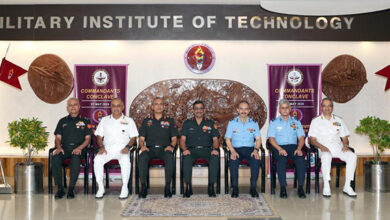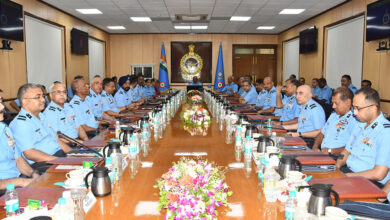Indian Military Aviation and The French Connection
Air Marshal Anil Chopra (Retd)
New Delhi. Indian Air Force’s (IAF) transition from the Mirage 2000 to Rafale was from one dream machine to another. In the initial training for Test Pilots, one is taught to assess an aircraft’s characteristics by just looking at it.

And one look at the wing-body blending, the shape of the intakes, the twist in the wing, the incline of fuselage, the size of the vertical stabilizer, the base of the wheels, all indicate some design features. For centuries, the French have been associated with finer things of life the cuisine, fashion, and their language was adopted by the kings and the courts, among many others. They have done well also in aviation.
After the WW II, aviation designer Marcel Dassault re-established the aviation industry. The M.D.450 (Marcel Dassault) Ouragan was the first French-designed jet fighter-bomber to enter production. The Ouragan was later operated by France, Israel, India and El Salvador. In June 1953, India ordered 71 Ouragans (Toofani). Finally 104 were bought.
IAF started to replace the Ouragan by the Mystère IVA in 1957. Toofanis were withdrawn fully from front line service in 1965, although they continued to be in use for some years as advanced trainer and for Target Towing. India procured 104 “supersonic-in-a-dive” Mystere. These aircraft were used extensively in the Indo-Pakistani War of 1965. On 7 September 1965, an Indian Mystere, piloted by Squadron Leader Devayya shot down a Pakistani Lockheed F-104 Starfighter in a raid over Sargodha.
Mystère IVs were also very successful in surface strikes. The aircraft were phased out by 1973.

Hindustan Aeronautics Limited (HAL) license-built versions of French Aérospatiale SA 315B Lama (designated Cheetah) and Aérospatiale Alouette III (designated Chetak) helicopters in mid-1960s. The Indian Navy procured 14 French Bréguet Br.1050 Alizé aircraft in 1960 for carrier-borne operations. French Turbomeca TM 333 2B2 engine powered initial HAL Dhruv helicopter, later replaced by the Shakti engine, which was jointly developed by HAL and Turbomeca. TM 333 2M2 powers HAL Cheetal and Chetan, upgraded versions of the Cheetah and Chetak, respectively.
IAF kept procuring Soviet aircraft for a long time from 1960s onwards. India did buy the Anglo-French SEPECAT Jaguar Deep Penetration Strike aircraft (DPSA) in late 1970s, but the contract was serviced by the British. IAF built and upgraded many Jaguars and continues to fly significant numbers even today.
India procured the Dassault Mirage 2000, multirole, single-engine jet fighter in 1984. It was the first relaxed stability fly-by-wire aircraft with active controls technology to induct in IAF.

The Thomson-CSF RDM multi-mode pulse-Doppler radar with an operating range of 54 nm (100 km), and with look-down/shoot-down capabilities, combined with the Super R530 missiles with effective range of 60-70 km, brought the beyond-visual-range (BVR) concept to IAF for the first time. The all-aspect Magic 2 missile changed the dynamics of close combat.
IAF also got the first comprehensive Electronic Warfare (EW suite) on any aircraft with a self-protection jammer, RWR, Chaff and Flare Dispenser, an escort jammer and an (Electronic Intelligence) Elint Pod. More recently the aircraft have been upgraded to Mirage 2000-5 Mk 2 standards, and extending its useful life for another 20–25 years. The upgrade included a new mission computer with higher memory, new radar, advanced navigation and EW systems, and other advanced communication and identification systems. The Mirage 2000-5 also has a new glass cockpit, and helmet-mounted displays.
Re-designated Mirage 2000I, the aircraft also got the MICA air-to-air missiles. It can also carry the Israeli Spice-2000 glide bomb and the indigenous Astra AAM. In September 2021, France agreed to sell around 24 retired Mirage 2000 airframes to India.
Mirage 2000 performed exceedingly well in the 1999 Kargil conflict, that took place over some of the highest terrain in the world, where aircraft and weapons had their own limitations. The targets were at 3-5 km altitude, and IAF engaged them with conventional and laser bombs. Easy maintenance and a very high sortie rate made the Mirage 2000 one of the most efficient fighters of the IAF in the conflict.
Later, the Mirage was the chosen platform for the Balakot Strike.
Medium Multi Role Combat Aircraft (MMRCA)
IAF needed newer and additional MMRCA. Requests for Information (RFI) were issued in 2004. Finally the aircraft in the fray for Indian tender were Lockheed Martin F-16C/D, Mikoyan MiG-35, Saab JAS 39 Gripen, Dassault Rafale, Eurofighter Typhoon, and the Boeing F/A-18E/F Super Hornet. The 126 aircraft deal was to be India’s mother of all (single largest) defence deals. The aircraft was to fill the gap between its future Light Combat Aircraft and the in-service Sukhoi Su-30MKI air superiority fighter.
On 27 April 2011, after an intensive and detailed technical evaluation by the IAF, two fighters, the Eurofighter Typhoon and Dassault Rafale cleared technical evaluation. On 31 January 2012 it was announced that Dassault Rafale won the competition due to its lower life-cycle cost. The French twin-engine delta-wing fighter aircraft is an omni-role fighter with frontal-stealth capabilities. It can simultaneously undertake air supremacy, interdiction, reconnaissance, and the airborne nuclear deterrent missions. And it is nuclear capable if required.
Rafale was inducted in the French Air Force and for carrier-based operations in the French Navy in 2000. Rafale has been used in combat over Afghanistan, Libya, Mali, Iraq and Syria. The aircraft uses digital fly-by-wire controls and has very high level of agility. The aircraft’s canards reduce the minimum landing speed to 115 knots (213 km/h) and better aircraft-carrier performance.
Data Fusion
The Rafale’s glass cockpit was designed around the principle of data fusion that prioritises information display to pilots. The primary flight controls are arranged in a hands-on-throttle-and-stick (HOTAS)-compatible configuration. The cockpit features a wide-angle holographic head-up display (HUD), two head-down flat-panel colour multi-function displays (MFDs) as well as a central collimated display. The cockpit is fully compatible with night vision goggles (NVG).
Rafale also features an advanced avionics suite. The passive front-sector electro-optical system can operate both in the visible and infrared wavelengths. The total value of the radar, electronic communications and self-protection equipment is about 30% of the cost of the entire aircraft.
Rafale features an integrated electronic survival system named SPECTRA, which protects the aircraft against airborne and ground threats. The system incorporates radar warning receiver, laser-warning, Missile Approach Warning (MAW) for threat detection plus a phased array radar jammer and a decoy dispenser for threat countering. Areos all-weather, night-and-day-capable reconnaissance system used on the Rafale has the ability to transmit information such as images in real-time to ground stations. The RBE2 AA Active Electronically Scanned Array (AESA) radar, a key requirement in the MMRCA RFI, has a arrange of 200 km.
The Rafale Deal
IAF acquired 36 aircraft, worth €7.87 billion (Rs 58,891 crore) in a Government-to-Government (G2G) deal, 28 of them single-seat fighters and eight twin-seat aircraft. The deal included tailor-made IAF specific enhancements including the integration of an Israeli helmet-mounted display (HMD), Radar Warning Receivers and low-band jammers. The deal included a weapons package and a performance-based logistics agreement.
The aircraft’s 14 hard-points can carry 9,500 kg external load. The air-to-air missiles include Matra Magic II, MBDA MICA IR or EM, and MBDA Meteor.
Meteor is an active radar guided Beyond Visual Range Air to Air Missile (BVRAAM). Meteor offers multi-shot capability against long range manoeuvring jets, UAVs and cruise missiles in a heavy electronic countermeasures (ECM) environment with range well in excess of 150 kilometres. The no-escape zone of over 60 km is the largest among air-to-air missiles, according to the manufacturer. India also procured SCALP air-to-ground cruise missiles, and subsequently, the HAMMER (Highly Agile Modular Munition Extended Range) glide bomb was negotiated. The Indian Rafale is a modified version of the F3R standard.
Delivered On Time
All the 36 contracted aircraft have been delivered, constituting two Squadrons at two different locations, with maintenance facilities. Both these airbases have infrastructure and capacity for an additional squadron each. The French have already tested the F4 variant with upgraded radar improved HMDS, OSF (Long-Range Optoelectronics System), IRST (Infra Red Search and Track) system which is another IAF requirement proposed in 2007, for detecting and identifying airborne stealth targets at long range. It will be more effective in network-centric warfare, with more data exchange and satellite communication capacity.
Way Ahead
Traditionally India and France have been enjoying an exceptionally warm relationship, which is the fruit of deep affinities and the unwavering trust between the two countries ever since India’s independence. France is considered as the most reliable Western ‘friend’. IAF regularly carries out Garuda series of air exercises with French Air Force since 2003; the latest “Garuda VII” was held at Jodhpur in November 2022.
IAF is already down to 30 fighter squadrons’ vis-à-vis the authorised 42 combat aircraft.
India has a two-front war threat. IAF urgently needs more fighter squadrons. The Request for Proposal (RfP) for 114 new “Make-in-India” is still to be sent out. There are media reports that Indian Navy has shortlisted Rafale-M as possible aircraft for its Carrier operations. In such a scenario, it may make better economic sense for IAF also to choose Rafale and acquire them in a G2G deal and make in India in larger numbers to amortise costs. What India will finally decide is still to evolve as the Ministry of Defence is looking for technology offsets by the winning OEM (Original Equipment Manufacturer) also to share engine and some other critical technologies towards eventually Making advanced fighter jets in India.
Howsoever, the decision on more aircraft for IAF, and the Navy’s requirement of shipboard fighters should be around in the near future.





